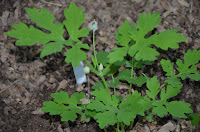
We finally got bees. On Saturday we drove out to Red Belly Bee Farm and picked up our first two packages of bees and brought them home with a mixture of anticipation, excitement, and a little anxiety. It has been a very long wait, but we can finally strike it off our list of things that we would like to try learning to do.
Bob packaged the nucs by stapling a piece of screen across the access hole and duct taping the top down so that they didn't bounce off on the drive home. I was very grateful that they were securely packed for the drive home, and we made it all the way back without incident.

Nathan(hesitantly) and I gently took the boxes to the back of the property where we will be placing them for now hoping that they are in a good place to take up residence.
The first box was really easy to settle in. I put on protective gear-hat, vale, and gloves-and carefully removed the staples and took of the screen. The bees slowly peeked out took a small flight around and quietly settled in for the evening.
The second box was a little bit different. I haven't had very much experience with bees, but with the little bit of exposure that I have had, I've quickly learned that a mashed bee means that there will possibly be trouble. I was optimistic though that the two smashed bees may not still cause too much excitement after a whole 40-ish minutes ride home...looking at the opening that was blocked with the screen quickly made me realize that this one was going to be a challenge. I puffed a bit of

smoke hoping it would help and gently began undoing the staples. The closer I came to releasing the screen the angrier the mob seemed. I told Nathan to stand a good distance back and released the flood. They were really angry and poured out of the opening to inspect the "danger" quite a few of them surrounded my area and I calmly smoked around me in hopes of distracting them, and then carefully walked toward Nathan to gently smoke the ones that were inspecting him for possible signs of "danger".

After a few minutes they lost interest and surveyed their area and then settled in for the evening.
We didn't panic, and we didn't get stung. I counted that as an extremely amazing and encouraging first encounter with our new bees. I am sure going forward there will be stings...probably quite a few, but for today we avoided that possible tragedy and move forward into the world of Beekeeping.
So...so far so good. Yesterday and today both hives seemed to be busy as...well...b

ees. Tomorrow we will try to open up the hives and see what's going on inside and attempt to move them into their new residence.
Here's to continued adventure of Our Handmade and Homegrown Life.
Hope you are having a beautiful beginning to your summer.













